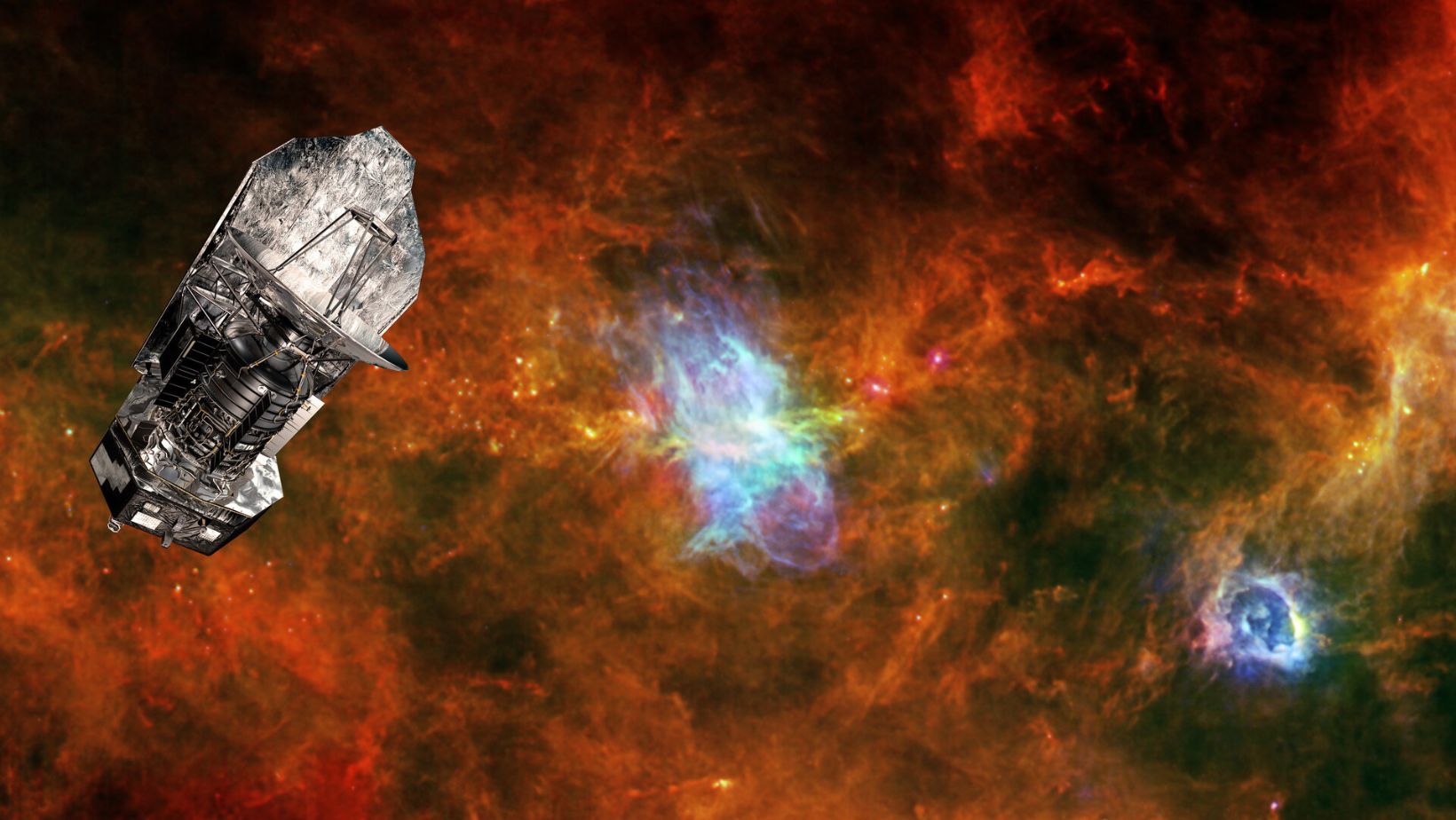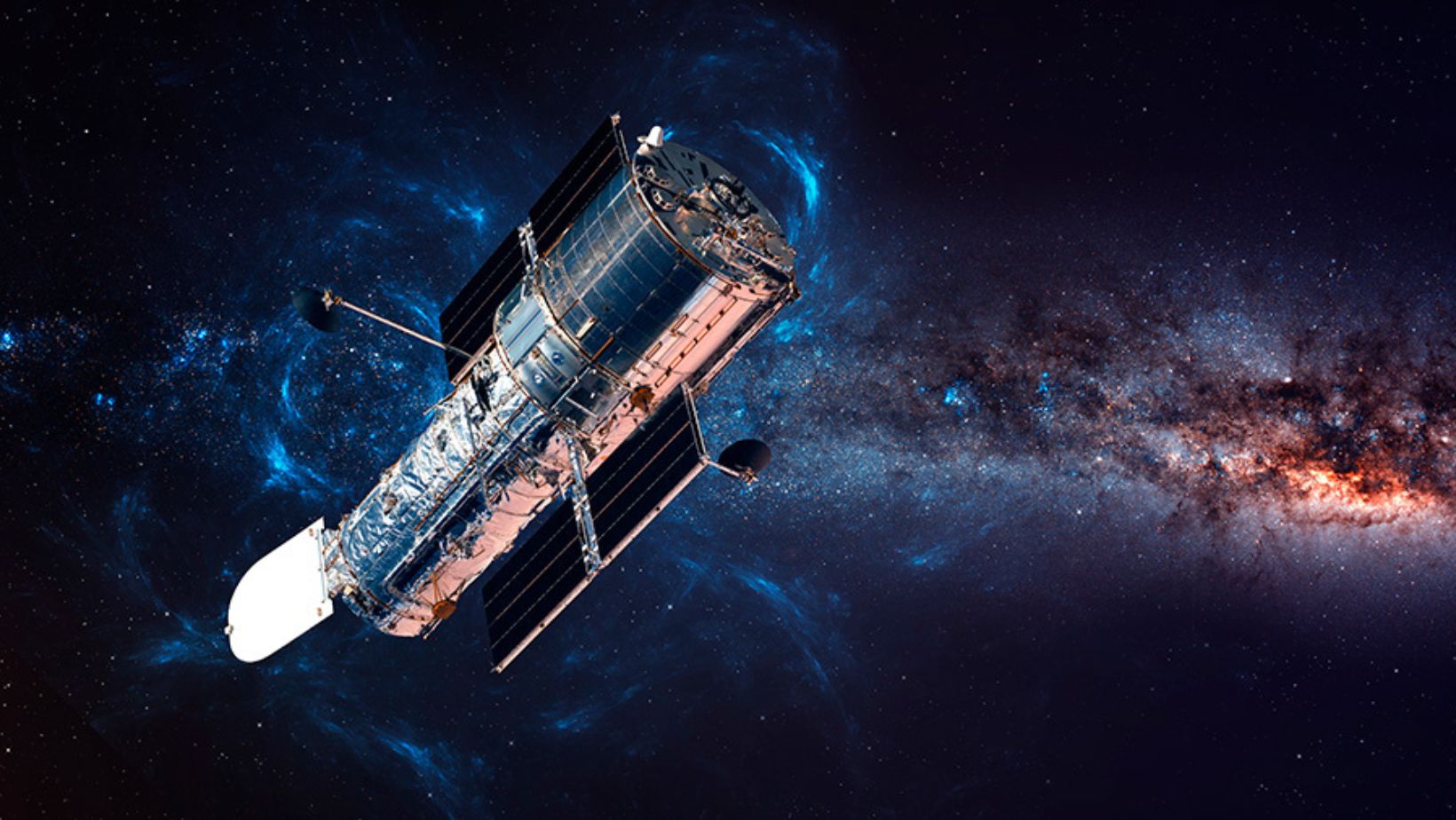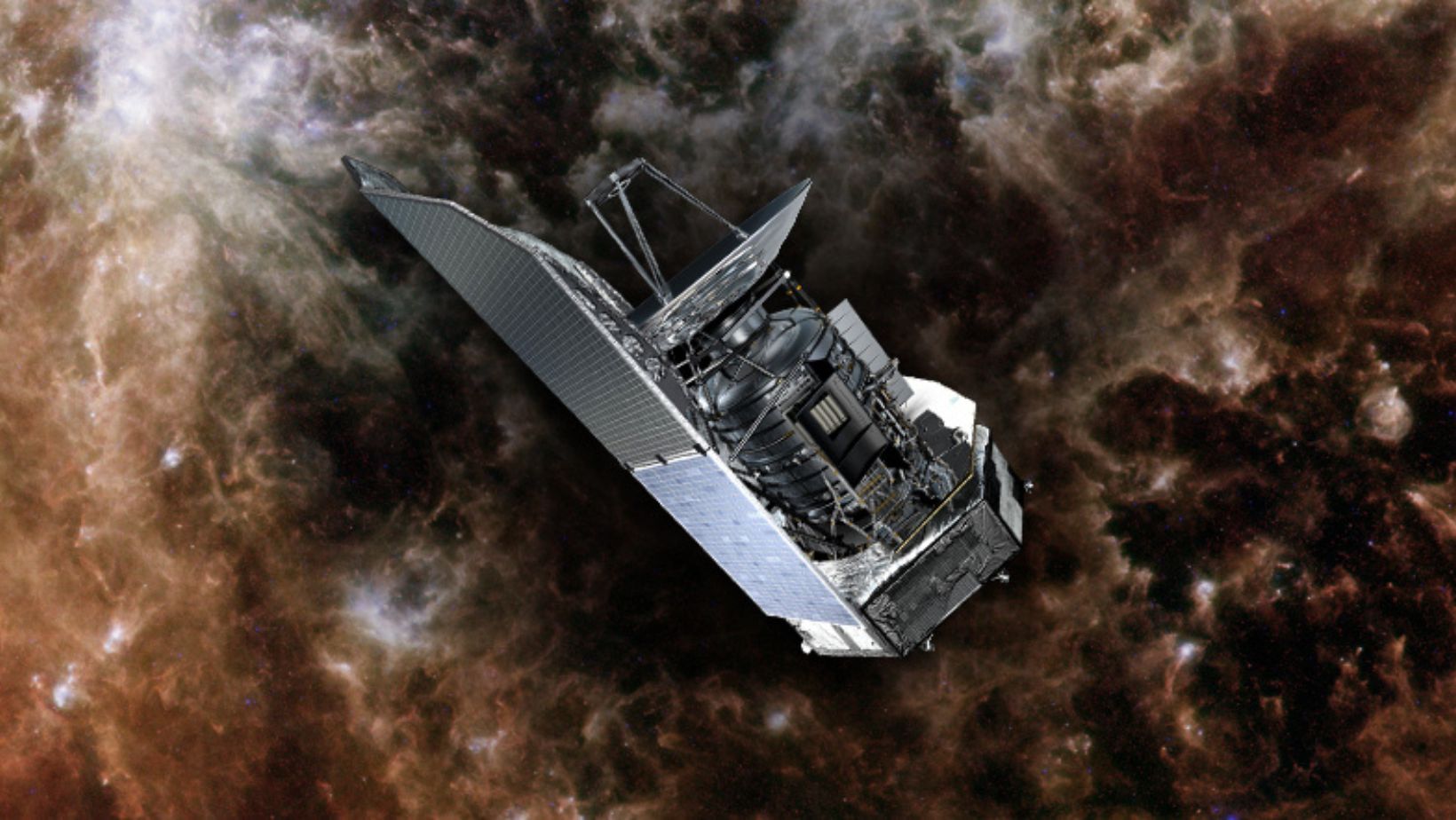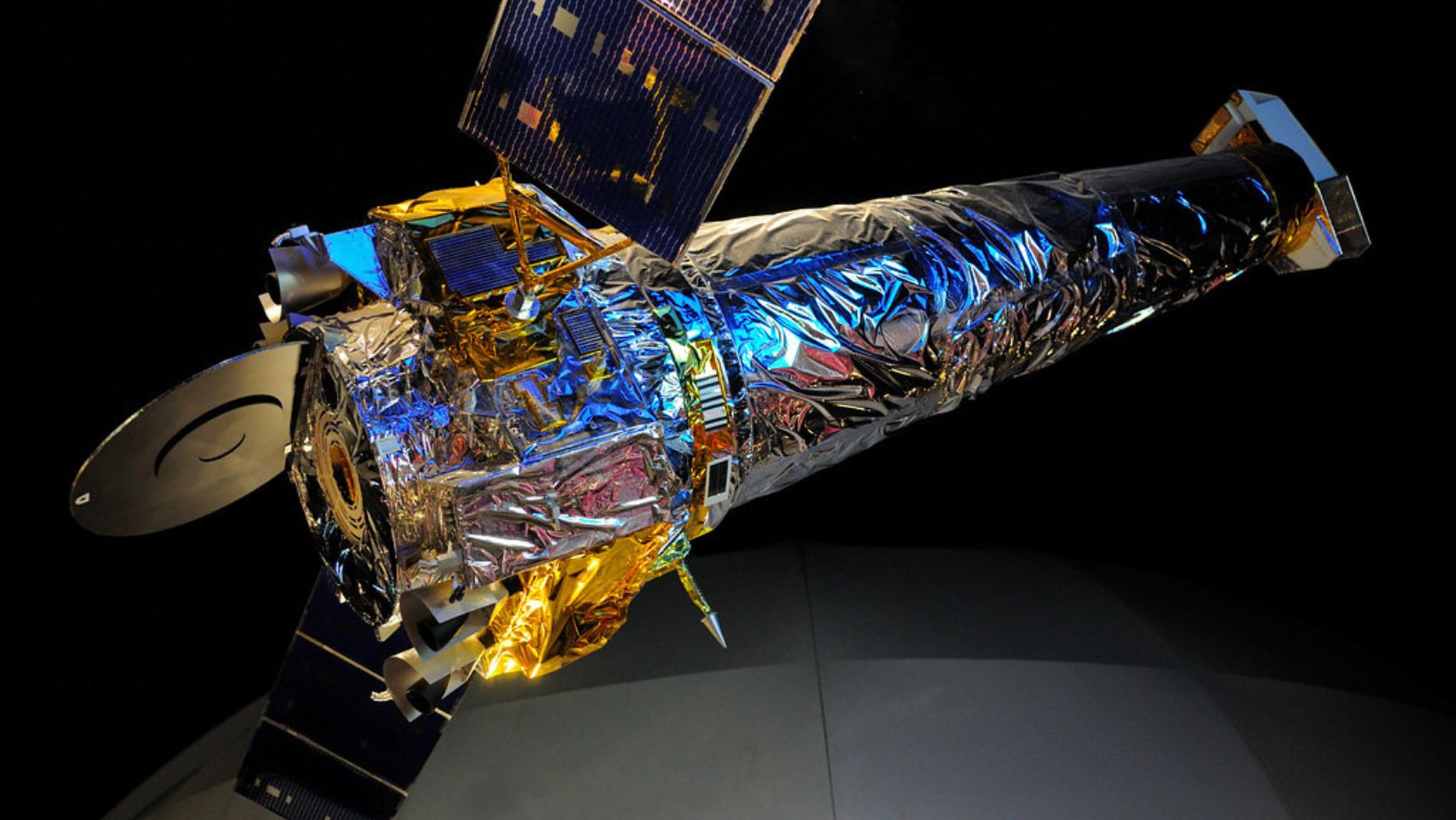Picture a toolshed where each gadget has its unique job. Now, imagine space as an infinite yard with mysteries in every corner. That’s precisely why are there different types of space telescopes – they’re the specialized tools astronomers use to unlock secrets across the vast cosmic garden.
Boldly peering into deep space, these scientific sentinels capture everything from black holes gobbling up stars to galaxies colliding in a cosmic dance. They work beyond Earth’s blurry atmosphere, giving us clear snapshots of events that have shaped our universe since the dawn.
Why are there different types of space telescopes? Because just like photographers need various lenses for other shots, astronomers rely on this diverse hardware to get the complete picture—through gamma rays or infrared light.
Get ready to explore the cosmos like never before. Explore the universe with us and discover all its wonders! From Hubble’s groundbreaking discoveries to the thrilling potential of what James Webb might uncover about distant worlds, this is a trip you won’t want to miss.
Table Of Contents:
- Understanding the Need for Different Types of Space Telescopes
- The Hubble Space Telescope’s Role in Astronomy
- Pioneering Infrared Astronomy with Spitzer and Herschel
- Delving into the High-Energy Universe with X-Ray Observatories
- Advantages of Observing Beyond Earth’s Atmosphere
- The James Webb Space Telescope: A New Frontier in Infrared Astronomy
- Future Prospects: Advancements in Space Telescopic Technology
- Comparing Ground-Based vs. Space-Based Astronomical Observations
- FAQs in Relation to Why Are There Different Types of Space Telescopes
- Conclusion: Why Are There Different Types of Space Telescopes?
Understanding the Need for Different Types of Space Telescopes
Imagine space as a grand stage where every star and galaxy puts on a cosmic show. But to catch all the action, you can’t just use any old telescope; you need an entire cast, each playing their part in unraveling the universe’s mysteries.
Electromagnetic Spectrum Exploration
Astronomers are like detectives piecing together clues from different wavelengths of light. That’s why they rely on various scientific instruments called space telescopes. Each type is fine-tuned to observe specific slices of the electromagnetic spectrum—like tuning into different radio stations with distinct music genres.
The Chandra X-ray Observatory, NASA’s premier X-ray detector, lets us peer into heated, high-energy scenes where black holes rule supreme. Meanwhile, infrared observatories such as Spitzer have unveiled hidden corners shrouded by dust clouds—a realm beyond visible light that only specialized sensors can reveal.
The Hubble Space Telescope’s Role in Astronomy
Sitting 347 miles above Earth since its launch aboard Space Shuttle Discovery, Hubble has been our eyes into deep space for over three decades. With its 2.5-meter diameter mirror capturing everything from ultraviolet to near-infrared light, this versatile telescope offers crisp views like celestial objects are putting on a parade just for us.
Pioneering Infrared Astronomy with Spitzer and Herschel
Beyond what meets the eye lies a cold universe filled with wonders best observed through infrared glasses—or should we say telescopes? Enter Spitzer and Herschel: one sports an 85cm lens while the other impresses with a mighty 3.5 meters across. They’re like undercover agents revealing secrets about star birth and galactic evolution by detecting heat signatures invisible to traditional scopes.
In essence, these telescopic titans join forces to give us comprehensive coverage across this vast electromagnetic frontier—from gamma rays captured by facilities akin to Compton Gamma-Ray Observatory, down through optical spectacles provided courtesy of good ol’ Hubble—and even further still towards long-wavelength radio signals detectable by giant arrays here on terra firma.
Key Takeaway: Why Are There Different Types of Space Telescopes?
Why are there different types of space telescopes? Space is a cosmic stage, and to catch the whole show, we need different space telescopes tuned to various wavelengths—like detectives using specialized tools to crack a case.
The Hubble offers crisp views across multiple light spectrums while Spitzer and Herschel uncover hidden heat signatures in infrared, showing us the universe’s coldest secrets.
The Hubble Space Telescope’s Role in Astronomy
Think of the Hubble Space Telescope (HST) as astronomy’s Swiss Army knife. Launched into Earth orbit by the space shuttle Discovery in 1990, this optical telescope has become a cornerstone of celestial observation. The reason? It captures stunning, high-resolution images across ultraviolet, visual, and near-infrared wavelengths with its impressive 2.5m diameter reflecting telescope.
A Revolution in High-Resolution Imaging
Hubble has made our cosmic backyard clearer than ever before. Dodging Earth’s atmosphere that blurs stellar and galactic light like fogged glasses delivers crisp snapshots from far-off galaxies to nearby nebulae.
This versatility lets astronomers peel back layers of cosmic mysteries—from tracking star formation to understanding black holes’ behavior—without leaving their desks. You can marvel at some of these incredible views on the telescope website.
The real kicker is how HST doesn’t just observe objects but helps scientists see processes unfold over time. This means watching stars being born or dying—a level of detail ground-based telescopes struggle to match due to atmospheric interference.
Navigating Through Time and Space with Precision
But wait—there’s more. With instruments like its guidance sensor for pinpoint accuracy or tools designed for expansive field views capturing vast swaths of the sky at once, HST is not just about taking pretty pictures; it’s an analytical powerhouse piecing together puzzles spanning billions of years.
Dive deep enough into those details using data collected during servicing missions performed by astronauts aboard shuttles like Columbia—you’ll find yourself tracing back through history until shortly after the universe said hello.
The James Webb Space Telescope is primed to take our comprehension of the universe to new heights. With its unprecedented resolution and sensitivity, it will examine every phase of cosmic history—from within our solar system to the most distant observable galaxies in the early universe. This powerful tool will give us insights into how stars and planets form and enhance our knowledge about atmospheres around exoplanets, some of which may even be capable of supporting life.
With the potential to uncover unknowns in space, we are on the brink of a scientific revolution. It’s an exciting time for anyone who has ever gazed up at the night sky with wonder. The data collected by this telescope promises to deepen our grasp on astronomical phenomena, cementing a legacy that will inspire future generations long after its mission concludes.
Key Takeaway: Why Are There Different Types of Space Telescopes?
Why are there different types of space telescopes? Like a Swiss Army knife for astronomers, the Hubble Space Telescope dodges Earth’s atmosphere to snap clear images of space. It captures snapshots and unfolds cosmic events precisely, paving the way for the James Webb Space Telescope to redefine our understanding of the universe.
Pioneering Infrared Astronomy with Spitzer and Herschel
Not all astronomical observatories are equivalent when unlocking the mysteries of the universe. The Spitzer Space Telescope, whose 85cm diameter mirror and the significantly larger Herschel at 3.5m, have been game-changers in infrared astronomy. These siblings in space give us VIP access to a cosmic show hidden from regular scopes.
Unveiling the Cold Universe with Herschel
Herschel has taken star gazing to new heights—literally and figuratively. Peeking into areas where stars are just beginning their lives, this observatory has helped scientists understand how galaxies evolve. It’s like having X-ray vision that cuts through dust clouds, which typically obscure our view from Earth.
The beauty of observing in infrared is that you can detect the heat of objects too cold for visible light detection; think of it as putting on thermal goggles for space exploration. This allows astronomers using Herschel, named after William Herschel, who discovered infrared light itself, to map out regions where new stars form within these cool dust enclaves—a process unseen by optical telescopes.
The other half of this dynamic duo is Spitzer. Despite being smaller than its counterpart Herschel, Spitzer punches above its weight class regarding sensitivity thanks mainly to liquid helium cooling systems that keep instruments at near zero temperatures – vital for precise IR observations without earthly interference.
Sitting pretty outside Earth’s atmosphere means these orbiting observers avoid atmospheric distortions altogether, giving them an edge over ground-based counterparts; plus, they don’t need sleep, so they work round-the-clock, capturing long uninterrupted data sets no ground telescope could dream of achieving.
Capturing Cosmic Clues with Spitzer
If you’re curious about what lies beyond twinkling stars or want clues about planets hanging around other suns, thank your lucky stars for tech marvels like Spitzer. By focusing on near-infrared wavelengths overlooked by Hubble’s gaze, we’ve gleaned insights into remote planet formations and even caught sight of potential solar system building blocks scattered across the Milky Way galaxy – talk about interstellar detective work.
Theories out of the water. The precision and depth of data we’re getting are reshaping our understanding of the cosmos, giving us insights into alien skies with potential for life as we know it. And that’s just scratching the surface.
Key Takeaway: Why Are There Different Types of Space Telescopes?
Why are there different types of space telescopes? Space telescopes like Spitzer and Herschel are cosmic superstars, giving us a sneak peek at the universe’s hidden gems. They spot heat from chilly objects invisible to regular scopes, reveal star birthplaces in dusty clouds, and work nonstop for crystal-clear infrared insights that ground telescopes can’t match.
Delving into the High-Energy Universe with X-Ray Observatories
The cosmos is a sprawling canvas of mysteries, and to unravel them, we’ve built telescopes that can detect more than just visible light. Think of it like having super-powered goggles; each space telescope gives us unique abilities to see the universe in different lights. For instance, Chandra’s X-ray Observatory, NASA’s most sophisticated yet, lets us peek at black holes and supernova remnants – stuff our eyes or even standard optical telescopes could never catch.
Chandra’s Advanced Capabilities
With Chandra’s launch by the space shuttle Columbia years ago, we’ve witnessed cosmic wonders in high definition. It’s all thanks to its advanced tech, which captures X-rays from hot regions of the universe. Hot spots like exploded stars and clusters of galaxies are now on full display for scientists hungry for knowledge about these high-energy environments.
You might wonder why we send such complex gear when we have powerful ground-based observatories. Well, here’s a nugget for you: Earth’s atmosphere acts like a murky pond that distorts starlight – not ideal if you’re trying to get crisp images from millions of miles away. By setting up shop beyond this atmospheric haze – 86 times higher than Mount Everest – Chandra enjoys long, uninterrupted looks at celestial phenomena without pesky interference.
XMM-Newton isn’t lounging around either; equipped with three high throughput X-ray telescopes itself—courtesy of our friends at the European Space Agency—it too is on an epic quest through outer space exploring what lies within intense gravitational fields surrounding neutron stars or feeding into monstrous black holes’ bottomless pits.
To sum it up, these two behemoths aren’t just fancy pieces of hardware floating in orbit—they’re vital scientific instruments making sure every time they beam back data across those tremendous cosmic distances, astronomers’ jaws drop as another piece falls into place, solving this grand puzzle called ‘the universe.’ And hey—if looking deep into space doesn’t make your inner nerd do somersaults—I don’t know what will.
Key Takeaway: Why Are There Different Types of Space Telescopes?
Why are there different types of space telescopes? Space telescopes like Chandra and XMM-Newton are our cosmic super-goggles, letting us see high-energy wonders that Earth’s atmosphere hides. They’re not just cool tech but key to piecing together the universe’s mysteries.
Advantages of Observing Beyond Earth’s Atmosphere
Imagine looking up at the night sky from your backyard. It’s a clear view, but not as crystal-clear as scientists get when they bypass our atmosphere and observe space directly from above it. Space telescopes can do just that, gifting us long, uninterrupted observations without atmospheric interference.
Extended Observation Periods
The beauty of space-based observatories lies in their ability to keep an eye on the cosmos for extended periods—something ground facilities can’t match due to Earth’s rotation and weather patterns. Without air to scatter light or clouds blocking the view, these high-flying scientific instruments provide out-of-this-world data.
This is why space telescopes like Hubble have become so crucial; they let astronomers study stars and galaxies continuously over hours—or even days—leading to more explicit images and deeper insights into celestial mechanics.
Crisper Cosmic Images
Away from Earth’s blurring atmosphere, observing beyond its blanket offers another distinct advantage: pristine image quality. Whether it’s capturing the birthplaces of stars hidden within nebulae or pinpointing distant planets around other suns—the clarity provided by orbiting observatories is unmatched by their earthbound cousins.
Instruments such as the James Webb Space Telescope (JWST), slated for groundbreaking studies on exoplanets and early universe formation—are expected to deliver views with unprecedented resolution thanks mainly to this freedom from atmospheric distortion.
Better Data Across The Spectrum
Surely enough, there isn’t one telescope that fits all needs in astronomy, which is why we’ve launched different types specialized for various parts of the electromagnetic spectrum—from radio waves to gamma rays. While some excel in sniffing out infrared signals indicating star formation zones obscured by cosmic dust, others hunt down X-rays emitted by black holes millions of light-years away, revealing secrets about their behavior.
Key Takeaway: Why Are There Different Types of Space Telescopes?
Why are there different types of space telescopes? Space telescopes take the viewing experience to a new level, free from Earth’s atmospheric tantrums. They deliver crisp images and nonstop cosmic data that ground-based scopes can only dream of.
The uninterrupted gaze of space observatories like Hubble leads to stunning clarity and in-depth universe insights, day or night, clear or cloudy.
Away from our atmosphere’s fuzziness, these high-flyers easily snag crystal-clear snapshots of distant stars and planets—a game-changer for astronomy.
Different space telescopes are tailor-made for all flavors of electromagnetic signals—some chase star birth clues while others expose black hole secrets millions of light-years away.
The James Webb Space Telescope: A New Frontier in Infrared Astronomy
The JWST’s launch has generated great excitement among astronomers worldwide, as it is expected to revolutionize our knowledge of the universe. It’s poised to observe exoplanets and delve into the early universe formation with a precision that was once only dreamt about. With its successful launch, astronomers around the globe are rubbing their hands together in anticipation.
The JWST operates like a time machine, capturing light from over 13 billion years ago. This means we’re not just looking at stars; we’re peering back into history—into an era when galaxies were young adolescents figuring out their place in this vast cosmic landscape.
This infrared telescope isn’t just any space powerhouse; it represents decades of innovation and international collaboration led by NASA and partners, including the European Space Agency (ESA). Imagine a detective meticulously searching for clues across every inch of a crime scene—that’s how JWST will scour through space for signs of star birth amidst clouds where visible light can’t penetrate.
Successfully Launched: Set to Observe Exoplanets
JWST has embarked on its mission fully equipped to characterize atmospheric composition, which could tell us heaps about potential life-sustaining planets beyond our solar system. The power behind these observations lies within its suite of instruments designed specifically for such delicate tasks as analyzing atmospheres hundreds or even thousands of light-years away—a testament.
Characterizing Atmospheric Composition
A closer look at alien worlds’ air might sound like science fiction, but rest assured; it’s very much reality thanks to this new frontier telescope whose mirrors span an impressive six-and-a-half meters. Not limited by Earth’s atmosphere, which distorts images seen from ground-based observatories—the JWST enjoys long uninterrupted stints staring deep into space, giving scientists data previously unattainable without interruption mainly because there aren’t pesky weather patterns messing up viewings out there.
For more information on this revolutionary instrument and what awaits us in explored realms, visit NASA’s dedicated James Webb Space Telescope website.
Key Takeaway: Why Are There Different Types of Space Telescopes?
Why are there different types of space telescopes? The James Webb Space Telescope kicks off a new era in space exploration, giving us a sneak peek into the universe’s early days and scouting for signs of life on distant exoplanets. It’s like having history and the future right at our fingertips.
Future Prospects: Advancements in Space Telescopic Technology
The next-generation telescopes on the horizon aren’t just overgrown versions of their predecessors; they’re brighter, sharper, and hungrier for the unknown. Think about a telescope that could unravel mysteries with every gaze into the abyss—a future where new missions make today’s discoveries look like child’s play.
Advancements in Technology
We’ve come a long way since Hubble was launched by the space shuttle, but hold onto your hats because things are getting even wilder. Imagine telescopes that can see through cosmic dust as if it were mere fog on a sunny day or pinpoint exoplanets with such precision that we might as well be knocking at their front doors. We’re talking about advanced instruments that could watch stars being born or spy on black holes as if attending an otherworldly matinee.
Spearheading this charge is none other than JWST—James Webb to its friends—the telescope expected to redefine our understanding of star formation and early universe antics. This isn’t just any infrared astronomy marvel; it’s set to observe exoplanets up close and personal, analyzing atmospheric compositions like never before.
New Missions & Discoveries
Astronomy buffs, prepare for severe fanfare because these new missions promise profound findings you’ll want to be tattooed across your memory banks. The leaps forward will let us scan entire sky vistas with unprecedented resolution—like swapping out binoculars for a high-powered telephoto lens on steroids.
The fun doesn’t stop there, either. These advancements wouldn’t be possible without teamwork, which makes the dream work. Collaborative efforts from global agencies fuel these endeavors – take the European Space Agency’s (ESA) contributions, which have been vital alongside NASA’s trailblazing steps towards tomorrow’s science fiction becoming today’s science fact.
Key Takeaway: Why Are There Different Types of Space Telescopes?
Why are there different types of space telescopes? Get ready to have your mind blown by next-gen space telescopes. They’re more significant than the Sherlock Holmes of the cosmos—brighter, sharper, and diving into mysteries with gusto. Picture instruments are so advanced that spotting new planets is a breeze, and peering at star birth or black holes feels like front-row seats to cosmic spectacles.
We’ve leveled up big time from Hubble’s days. Now, we can cut through cosmic dust easily and spot exoplanets with crazy precision. And keep an eye on JWST—it will change everything we thought we knew about stars and early universe drama.
Astronomy enthusiasts, get ready for some mind-blowing revelations. We’re looking at unprecedented clarity in our celestial observations, outshining the capabilities of older technology by miles. This leap forward is a testament to international collaboration—scientists and stargazers pooling their expertise to unlock the secrets of the universe.
Comparing Ground-Based vs. Space-Based Astronomical Observations
Gazing into the darkness of night, what wonders can be seen? If your answer is “not much,” then you’re in for a treat because ground-based facilities like ALMA and space-based telescopes are changing that narrative. The Atacama Large Millimeter/Submillimeter Array (ALMA), with its complex radio interferometer and numerous antennas high in the Chilean Andes, captures signals from cosmic hideaways.
Now contrast this with siblings orbiting Earth – our beloved space observatories. Far above any atmospheric fickleness, they enjoy an unobstructed view of the universe’s grandeur. Without batting an eye- or lens, there is no need to worry about pesky weather or earthly blurs; these celestial spies clarify our understanding of star formation and galaxy evolution.
The Atacama Large Millimeter/submillimeter Array (ALMA)
Dishing out details on deep-space wonders is ALMA’s forte, thanks to its extensive array. It sees the universe through millimeter and submillimeter wavelengths—a spectrum slice that tells tales of cold interstellar clouds where stars are born. With Subaru’s 8.3m diameter gaze and Keck’s dual 10m behemoths peering into the cosmos, one might think we’ve seen it all—but not quite.
Astronomy enthusiasts rave about J-VLA’s intricate dance as part of a vast network capturing radio waves—the secret whispers between celestial bodies—yet even these giants stand dwarfed when compared to their kin floating serenely above Earth’s turbulent atmosphere.
Jansky Very Large Array (J-VLA)
Moving to New Mexico brings us face-to-face with J-VLA—like standing amidst a forest where each tree listens intently for nature’s faintest rustle from distant universes unseen by naked eyes but never unheard by this impressive instrument stretching across plains whispering secrets into science’s eager ears.
Discover more about how ground powerhouses like ALMA shape stories woven from cosmic threads invisible except through technological marvels here on terra firma or catch glimpses offered by advanced tools sailing silent skies—all working tirelessly whether anchored by gravity or graced with weightlessness—for astronomy knows no bounds when questing after knowledge beyond reach until now.
Key Takeaway: Why Are There Different Types of Space Telescopes?
Why are there different types of space telescopes? Ground-based facilities like ALMA and space telescopes are revolutionizing how we see the cosmos. From high in the Andes to orbiting Earth, these observatories give us clear, unobstructed views that reveal star births and galaxy evolution.
The universe tells its story through different wavelengths—whether radio waves caught by J-VLA or deep-space details from ALMA—both ground and space instruments are vital to hearing it all.
FAQs in Relation to Why Are There Different Types of Space Telescopes
Why do we have different types of telescopes?
Different scopes let us look at cosmic wonders in varied light, revealing secrets across the electromagnetic spectrum.
Why are there different types of telescopes that scientists use to study space?
Scientists need a range of telescopes because each kind captures distinct aspects and phenomena in the cosmos.
Why are certain telescopes in space?
We put some scopes out there to bypass Earth’s blurry atmosphere for crystal-clear celestial snapshots and nonstop observation.
Why are different telescopes used to observe the universe?
Varying telescope designs suit specific research goals; they grab stellar data from gamma rays to radio waves.
Conclusion: Why Are There Different Types of Space Telescopes?
Space is vast, and its mysteries are complex. To understand it all, why are there different types of space telescopes? Simple – diversity unlocks the universe’s secrets.
You’ve seen how each telescope serves a unique purpose. Hubble’s sharp eyes catch distant galaxies in stunning detail. Spitzer and Herschel unveil the cold cosmos where stars are born from dust. Chandra delves deep into high-energy wonders like black holes.
And beyond Earth’s muddling atmosphere, these sentinels watch longer and see clearer. They bring us closer to answering age-old questions about our place among the stars.
Soon, James Webb will join them, promising new revelations on exoplanets and ancient cosmic light shows.
In this journey through space telescope, remember: Variety isn’t just spice; it’s science – allowing us to capture every corner of an infinite yard brimming with celestial surprises.

